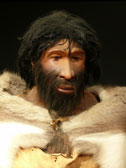Neanderthal Genome

In high school, I was actually called a Neanderthal because I played football. It wasn't flattering then and it isn't now... but maybe it should be.
That's because researchers have just published much of the DNA sequence of the Neanderthal genome. Since Neanderthals are closely related to humans, this work will allow incredible insights into human evolution.
Neanderthals first appeared around 400-thousand years ago and were found across Europe and Asia before they became extinct about 30-thousand years ago.
Why they disappeared is unknown, but some speculate modern man out competed them.
As for the Neanderthal genome – just getting it was an accomplishment. Researchers had to extract DNA from less than one-half of a gram of pulverized bone taken from three, 38-thousand year old female Neanderthals. The researchers had to overcome a myriad of problems.
First, the stability of DNA from samples that old was in question. Then the greatest challenge was differentiating the Neanderthal DNA sequence from the sequences of bacteria that invaded the bone during decomposition, plus ones that came from other contaminants.
Talk about a "needle in a haystack." Nearly 97% of the DNA recovered from these samples was from the contaminants.
But the work was well worth it. For the first time, we're able to identify the genetic differences between us and Neanderthals.
What's astounding is: the DNA sequences show humans interbred with Neanderthals! That may have occurred in the Middle East 45– to 80–thousand years ago when early humans left Africa on their way to Europe and Asia.
Estimates are that between 1 and 4 percent of the human genome of non-Africans comes from Neanderthals.
Amazing – the girls in my high school were pretty smart. They were right all along!
More Information
Neanderthal genome reveals interbreeding with humans
Article in the New Scientist that describes how the sequencing of the Neanderthal genome and the implications after its comparison to the human genome.
For more information...
A Draft Sequence of the Neanderthal Genome
Original research article in Science magazine
"Abstract (from Science): Neanderthals, the closest evolutionary relatives of present-day humans, lived in large parts of Europe and western Asia before disappearing 30,000 years ago. We present a draft sequence of the Neanderthal genome composed of more than 4 billion nucleotides from three individuals. Comparisons of the Neanderthal genome to the genomes of five present-day humans from different parts of the world identify a number of genomic regions that may have been affected by positive selection in ancestral modern humans..."
For more information...
Science 7 May 2010:
Vol. 328 no. 5979 pp. 710-722
DOI: 10.1126/science.1188021
Neanderthal Genome Shows Most Humans Are Cavemenz
Wired science article that talks about the implications of the research that shows that humans carry pieces of Neanderthal genes in our chromosomes today and the implications for humans today.
For more information...